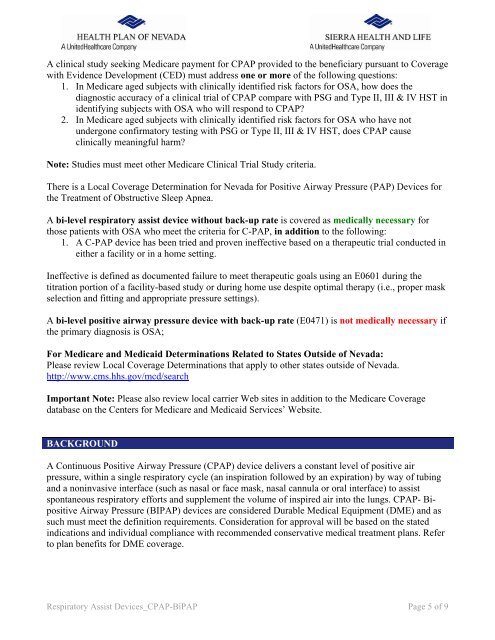Respiratory Assist Devices CPAP-BiPAP - Health Plan of Nevada
Respiratory Assist Devices CPAP-BiPAP - Health Plan of Nevada
Respiratory Assist Devices CPAP-BiPAP - Health Plan of Nevada
Create successful ePaper yourself
Turn your PDF publications into a flip-book with our unique Google optimized e-Paper software.
A clinical study seeking Medicare payment for <strong>CPAP</strong> provided to the beneficiary pursuant to Coverage<br />
with Evidence Development (CED) must address one or more <strong>of</strong> the following questions:<br />
1. In Medicare aged subjects with clinically identified risk factors for OSA, how does the<br />
diagnostic accuracy <strong>of</strong> a clinical trial <strong>of</strong> <strong>CPAP</strong> compare with PSG and Type II, III & IV HST in<br />
identifying subjects with OSA who will respond to <strong>CPAP</strong>?<br />
2. In Medicare aged subjects with clinically identified risk factors for OSA who have not<br />
undergone confirmatory testing with PSG or Type II, III & IV HST, does <strong>CPAP</strong> cause<br />
clinically meaningful harm?<br />
Note: Studies must meet other Medicare Clinical Trial Study criteria.<br />
There is a Local Coverage Determination for <strong>Nevada</strong> for Positive Airway Pressure (PAP) <strong>Devices</strong> for<br />
the Treatment <strong>of</strong> Obstructive Sleep Apnea.<br />
A bi-level respiratory assist device without back-up rate is covered as medically necessary for<br />
those patients with OSA who meet the criteria for C-PAP, in addition to the following:<br />
1. A C-PAP device has been tried and proven ineffective based on a therapeutic trial conducted in<br />
either a facility or in a home setting.<br />
Ineffective is defined as documented failure to meet therapeutic goals using an E0601 during the<br />
titration portion <strong>of</strong> a facility-based study or during home use despite optimal therapy (i.e., proper mask<br />
selection and fitting and appropriate pressure settings).<br />
A bi-level positive airway pressure device with back-up rate (E0471) is not medically necessary if<br />
the primary diagnosis is OSA;<br />
For Medicare and Medicaid Determinations Related to States Outside <strong>of</strong> <strong>Nevada</strong>:<br />
Please review Local Coverage Determinations that apply to other states outside <strong>of</strong> <strong>Nevada</strong>.<br />
http://www.cms.hhs.gov/mcd/search<br />
Important Note: Please also review local carrier Web sites in addition to the Medicare Coverage<br />
database on the Centers for Medicare and Medicaid Services’ Website.<br />
BACKGROUND<br />
A Continuous Positive Airway Pressure (<strong>CPAP</strong>) device delivers a constant level <strong>of</strong> positive air<br />
pressure, within a single respiratory cycle (an inspiration followed by an expiration) by way <strong>of</strong> tubing<br />
and a noninvasive interface (such as nasal or face mask, nasal cannula or oral interface) to assist<br />
spontaneous respiratory efforts and supplement the volume <strong>of</strong> inspired air into the lungs. <strong>CPAP</strong>- Bipositive<br />
Airway Pressure (BIPAP) devices are considered Durable Medical Equipment (DME) and as<br />
such must meet the definition requirements. Consideration for approval will be based on the stated<br />
indications and individual compliance with recommended conservative medical treatment plans. Refer<br />
to plan benefits for DME coverage.<br />
<strong>Respiratory</strong> <strong>Assist</strong> <strong>Devices</strong>_<strong>CPAP</strong>-<strong>BiPAP</strong> Page 5 <strong>of</strong> 9
















